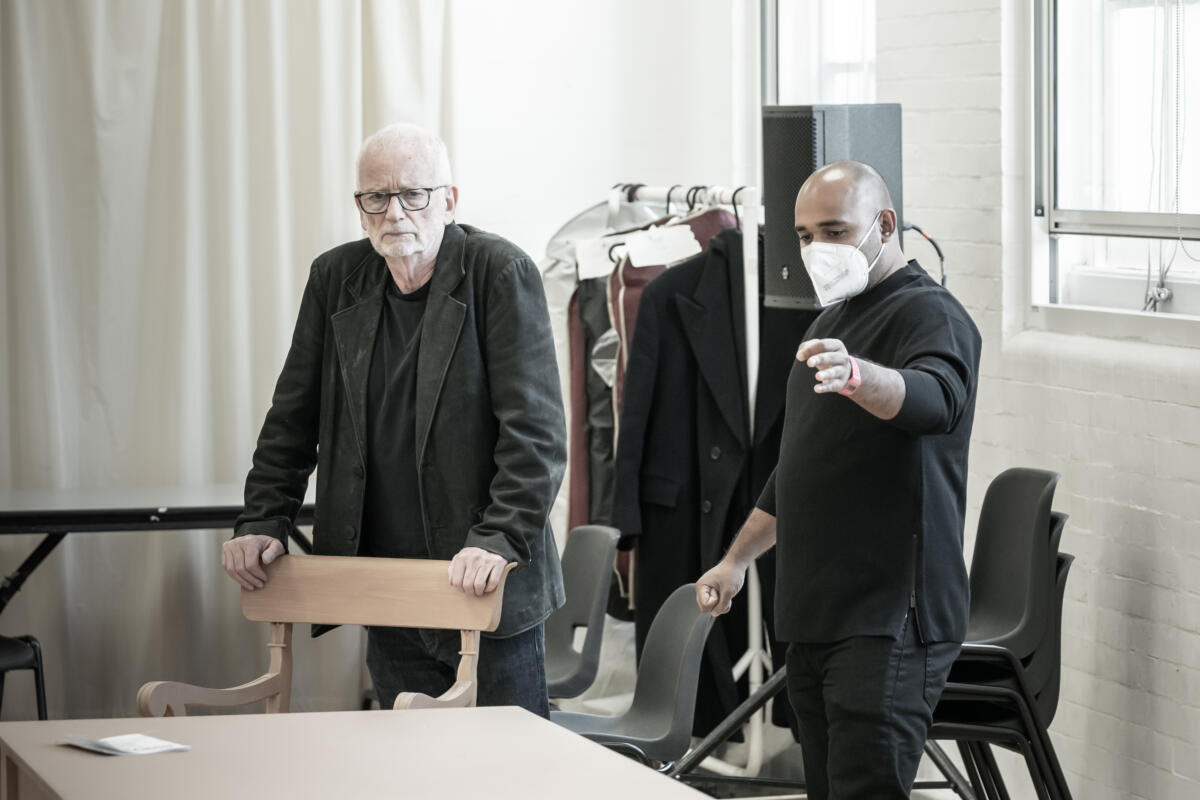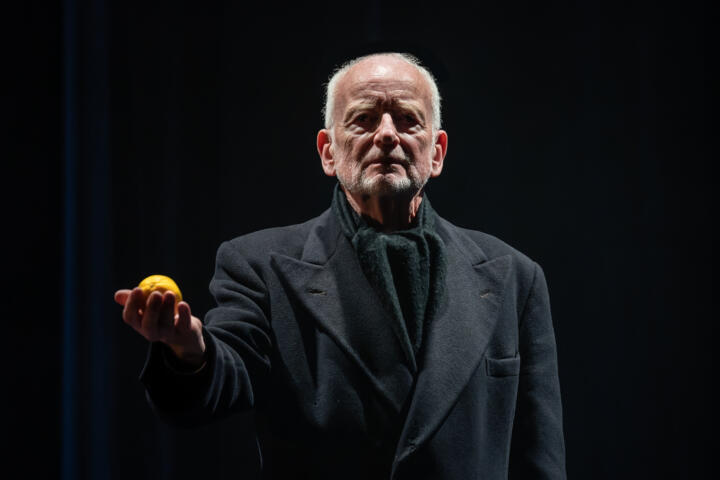The Lemon Table | Extras
The Lemon Table– Inside the Rehearsal Room
Education Associate Dominic Francis provides an insight into the cast and Creative Team’s rehearsal process for The Lemon Table

It’s day two of the second, and last, week of rehearsals for The Lemon Table. Including the production week, when lights and sound are added in the first venue on the tour (Salisbury Playhouse), the play has just over two and a half weeks of rehearsals, from readthrough to opening night. It being a solo show, which actor Ian McDiarmid has adapted himself from Julian Barnes’ short stories of the same name, it’s felt that this is sufficient time. The rehearsal venue is a familiar one – the Jerwood Space in Southwark where many of Michael Grandage’s past productions have been created.

Leading today’s rehearsal is co-director, Titas Halder, who’s previously worked with Michael at the Donmar Warehouse. It’s a small team in the room: two members of Stage Management alongside Sound Designer Ella Wahlström, plus Titas and Ian. The day has started with a photo shoot as part of the production’s publicity and now the team are waiting for Ella to set up the sound.
A long table and two matching chairs dominate the space. This, essentially, is the set. Drawings and photographs of the model box by designer Frankie Bradshaw reveal, additionally, a frame and curtain at the rear, all of which is accommodated on a raised platform of bare wooden boards. It’s an austere yet striking environment.

‘This is quite a gentle session for us,’ explains Titas. ‘This morning’s plan is to go over the new sounds.’ Having incorporated these into the performance they’ll then do a run of the show. While waiting for Ella, Titas suggests they do a ‘chair call’, meaning the various positions of the two chairs throughout the piece. Ian walks slowly through the choreography, taking note of marks on the floor put down by Stage Management to help him remember. During these quiet moments he runs lines under his breath, consolidating these with the blocking.

Ella’s nearly finished setting up and Sibelius’ music can be heard playing in the background. Even at a low volume it manages to be incredibly powerful and stirring. Ian is hopeful that the show will encourage audiences to listen to more of his work. Various sound effects are heard, notably the call of cranes flying overhead at the end of the piece. It’s very loud and Titas assures Ian that it will be quieter in performance. They now work on this section in detail, incorporating both sound effects and music. ‘You focus on what you need to do,’ Titas says to Ian, ‘and we’ll put the levels in around you.’ They work carefully together through the piece, Ian checking in frequently with Titas and Ella: ‘Cranes going throughout that, yes? … I don’t think we want the wind on this bit.’

They’re trying to establish the right tone for the end of the play. ‘In my head, I’m wondering if there should be something about what music means to him, a glow,’ suggests Titas. ‘It’s like a little focus pull, just to make us pay attention.’ Ian agrees: ‘Something very gentle, something from the 5th.’ They both understand the need for sensitivity with regard to sound. ‘We don’t want to overdo it,’ observes Ian, ‘it’s a subtle thing. We should never be underscoring.’ Titas thinks the music is there to ‘expand or intensify a feeling, to reach out and squeeze the audience’s heart’. He puts himself in the position of the spectator: ‘I want to understand what’s in the character’s head – we need to help the audience.’

They go over the ending again, trying to get the timings right. ‘Maybe the sound could come in after I say, “Sounds that pierce the heart…”?’ suggests Ian. ‘Can I have a second there?’ he asks Titas and Ella, referring to the character’s final moments, before the sound of the cranes is introduced. ‘Can I become a corpse first? When should it fade exactly?’ Ian congratulates Ella on the overall design and Titas comments on how delicately she’s blended the ambient noises with Sibelius’ music: ‘There was a moment there where I wasn’t sure if I was hearing wind or strings.’
The main focus of the session is on timings and levels. Occasionally Ian thinks the music is working against the lines: ‘At the moment it’s contradicting the sense of what I’m saying.’ Everyone works together to resolve this. ‘Shall I go back?’ asks Ian. ‘What’s helpful?’ For now Titas suggests to Ella where the sound should come in and out. ‘I’ll stop stopping,’ says Ian, ‘and carry on regardless.’ He’s mindful that it’ll sound different in the various venues anyway. Titas reassures him that it’s important he feel comfortable with the sound: ‘We need to have a language for communicating that in the room – what does and doesn’t work.’

He reflects on the contrast between the full soundscape and silence: ‘When we take the music away, there’s lots of space.’ At the climax of the scene and Sibelius’ 5th symphony, which accompanies it, Ian’s character waves his arms majestically as though conducting. ‘Even louder,’ he calls to Ella, ‘as if the orchestra is in the room. Don’t worry about it competing with me, I’ll compete with it!’ The last detail to be timed to perfection is the final moment of the play, when Ian reveals a lemon clasped in his outstretched hand, his fingers opening on the final chord of the symphony.
After a short break they run the whole of the second half, called ‘The Silence’. It goes well, Ian commenting afterwards, ‘I felt all of the pieces in that one’. For the first time all of the elements seemed to be in place – further discoveries and the consolidation of details will take place in the remaining rehearsals. Reflecting on the runthrough, Ian observes: ‘I kept thinking I was going to dry, but I was able to use it – I usually do.’ His only concern is one of stamina. ‘I hope I’ve got the energy to do it (‘The Silence’) after the first one.’

There’s another brief break and then they run the first half, called ‘Vigilance’. Despite giving a powerful performance, Ian doesn’t feel it went as well as ‘The Silence’ and is apologetic. ‘I’m tired,’ he says simply. Titas isn’t concerned and reassures him with regard to solo shows, ‘It’s like running a marathon – you have to build up to it. And there’s a point in the rehearsal process when it hits you. Your stamina will increase.’

Taking out a notepad and pen to make his own notes, Ian asks the Deputy Stage Manager to highlight the parts of the script which he forgets in future run throughs. Titas also asks her to help him make a ‘working list’ of notes for tomorrow’s rehearsal, starting with looking again at the sound in specific places, which he refers to as, ‘Joining everything up’. Titas’ notes to Ian range from highlighting an incorrect word – ‘severity of style’ not ‘austerity’ – to thoughts about the sound and its relation to other (unseen) characters: ‘I think Aino (Sibelius’ wife) needs a motif. Each moment should be different, but it’s punctuated in the effect she has on him.’

Referring to ‘The Silence’ and the character’s alcoholism, Titas asks, ‘Ian, after you’ve taken the bottle, do you want to recover completely before you go out?’ He thinks the character would tidy himself up before dinner with friends. ‘He might be a drunk passed out on the floor, but he’s high-functioning in public.’ Ian agrees: ‘Absolutely, that’s very good.’ Some of Titas’ notes are directed at Ella: ‘What do we do after the bottle is thrown? There’s a definite change of air – something building, a moment of crescendo.’
Having talked through the notes for ‘The Silence’, they then focus on ‘Vigilance’. Titas thinks the orchestra at the beginning shouldn’t sound real – it should be in the character’s head. While he continues to discuss notes with Ella, Ian quietly runs through lines and blocking in the space.


